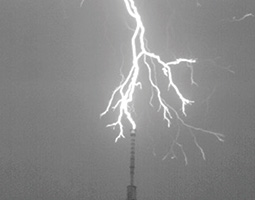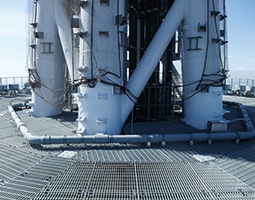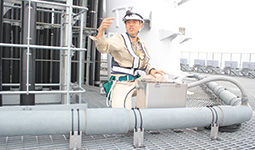Home > Highlighting JAPAN > Highlighting Japan October 2017 > Science & Technology
Highlighting JAPAN
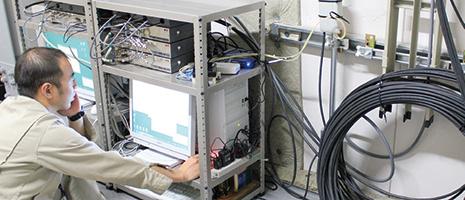
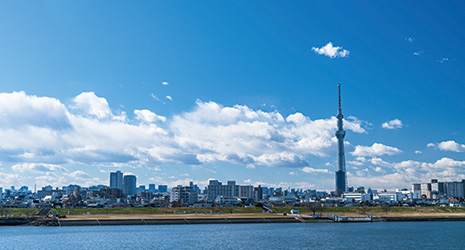
Lightning Observations at the Tokyo Skytree
The Tokyo Skytree, a popular tourist spot, has been playing an important role as a lightning observation station.
In 1752, Benjamin Franklin flew a kite in a lightning storm to prove the electrification of thunderclouds. More than 260 years have passed since this experiment, which proved that lightning is electricity, yet many aspects of lightning still remain unknown today. This is because it is difficult to predict where lightning will strike and make preparations for observing it directly in these spots.
It is hard to predict where lightning will strike in flat areas. However, high-rises make lightning observations possible. This is an observation method that makes the most of lightning’s tendency to strike high places. To cite examples from the past, lightning observations had been conducted on high-rises such as the CN Tower in Toronto (553 meters high), the Ostankino Tower in Moscow (540 m) and the Empire State Building in New York (443 m). At present, lightning observations are performed on the Tokyo Skytree (634 m), the tallest freestanding broadcasting tower in the world. By the end of March 2017, about 26,310,000 people had visited the Tokyo Skytree, which was opened to the public in May 2012. The total number of visitors reaches 183,530,000 when visitors to an attached commercial complex (TOKYO SKYTREE TOWN) are included in the count.
“Lightning observations at the Skytree are aimed at monitoring lightning to prepare for lightning damage while at the same time obtaining scientific data about lightning,” explains Toru Miki, a member of the Central Research Institute of the Electric Power Industry in charge of lightning observations at the Tokyo Skytree. “We can use the data for measures designed to effectively and efficiently protect high-rises, power utilities, information equipment and the like from lightning.”
At the Tokyo Skytree, devices for measuring electricity called Rogowski coils installed at a point 497 meters above the ground are monitoring time changes in lightning currents. Made of copper, the Rogowski coils are about 30 meters long. They are installed to enclose the steel frames of the tower completely. Lighting current runs deep into the ground by way of the steel frames when lightning strikes the top of the Tokyo Skytree. Data, such as the waveform of the electric current, in other words the amplitude of the current, and the amount of time electricity flows, are obtained by detecting the lightning current with the coils.
In addition, electromagnetic waves that spread in all directions with the lightning current at the Tokyo Skytree are observed in Abiko, Chiba Prefecture, 27 kilometers to the northeast of the tower, Yokosuka, Kanagawa Prefecture, 57 km to the southwest, and Akagi, Gunma Prefecture, 101 km to the northwest. Data on electromagnetic waves obtained at these sites can be utilized for the development of technologies for specifying lightning strike points with high accuracy by combining them with data on lightning currents obtained at the Tokyo Skytree. Furthermore, the Tokyo Skytree is photographed from three directions using multiple cameras, including high-speed cameras that are capable of taking 180,000 frames per second. The moments of lightning strikes on the tower are recorded in the form of moving images.
“We can obtain a range of weather data in Tokyo, including temperature, atmospheric pressure and precipitation,” says Miki. “We can analyze individual lightning strikes in detail by combining this data with our observation data. Researchers around the world take an extremely high level of interest in our observations because locations blessed with such good conditions for lightning observations are rare.”
In Tokyo, lightning occurs twice each year per square kilometer, on average. However, lightning has struck the Tokyo Skytree 62 times since 2012, when observations were launched. Strikes on the tower average more than 10 per year.
One of the observation results that has become known up to this point is that lightning occurs in both the upward and downward directions. Lightning, which is an electric discharge between negatively or positively charged thunderclouds and the ground, not only strikes the ground in the downward direction, but also extends upward from structures such as high-rise buildings, steel towers and windmills to thunderclouds, in some cases. Lightning observed at high-rises such as the CN Tower has traveled upward in almost all cases. However, upward lightning occurred 37 times compared with the 25 times downward lightning on 62 strike occasions observed at the Tokyo Skytree. The Tokyo Skytree is a valuable observation point in the world that enables the observation of the characteristics of both downward and upward lightning.
In lightning studies, data observed in the mountains of Switzerland in the 1970s are still used as basic data today. Data observed at the Tokyo Skytree in Japan will offer a new viewpoint to lightning studies if and when their accumulation advances.
“Lightning injures people and causes damage to buildings every year,” points out Miki. “We would like to contribute to the realization of a safer society by elucidating the characteristics of lightning.”
In addition to lightning, greenhouse gases such as carbon dioxide and airborne substances like PM2.5 are observed at the Tokyo Skytree. The tower, which plays the role of a facility for scientific observations as well as for sightseeing and broadcasting, is expected to provide us with even more results in the future.
© 2009 Cabinet Office, Government of Japan
